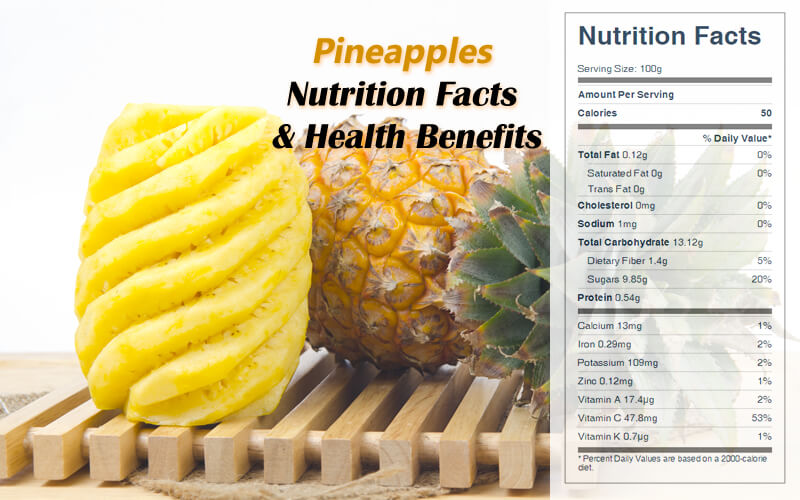Pineapples Nutrition Facts & Health Benefits
Pineapple is a superfood that like other bright yellow foods, pineapple is high in vitamin C. What makes pineapples unique is the enzyme bromelain. Here are nutrition benefits of pineapples.
One cup of raw pineapple pieces provides 76 calories, 8.4 g carbohydrate, 0.2 g protein, 0.1 g fat, 2.3 g dietary fiber, 17 mg vitamin C, 78 mg potassium, 7 mg calcium, and 7 mg phosphorus.

Raw pineapple pulp is 86% water, 13% carbohydrates, 0.5% protein, and very low in fat. It is a good source of manganese, vitamin B1, and vitamin C.
Raw Pineapple Nutrition Facts Label
Health Benefits of Pineapples
Pineapple fruits and peels contain diverse phytochemicals, among which are polyphenols, including gallic acid, syringic acid, vanillin, ferulic acid, sinapic acid, coumaric acid, chlorogenic acid, epicatechin, and arbutin.
Pineapple is rich in beta-carotene, B-complex vitamins, vitamin C, magnesium, manganese, potassium, carbohydrates, and fiber. Pineapple also contains the protein-digesting enzyme bromelain, a powerful anti-inflammatory agent that is believed to block inflammatory prostaglandins and inhibit blood platelet aggregation. It can have a significant effect on allergy sufferers as it works to balance the immune system’s response. Combing a serving of pineapple into your diet can modulate the immune system and support the anti-inflammatory mechanism.
Pineapple has antibacterial, antiviral, demulcent, diuretic, and mild phytoestrogenic properties. It cools the blood, helps the skin retain youthfulness, promotes bone density, and speeds healing after an injury. It has been used to treat angina, arthritis, blood clots, bronchitis, catarrh, constipation, diphtheria, dyspepsia, edema, goiter, hypertension, indigestion, excessive menses, multiple sclerosis, obesity, sinusitis, sore throat, sunstroke, and tumors, and to expel intestinal worms. Pineapple is very helpful in cases of fever with sweating and much body heat. Topically, it can be used to relieve swelling and speed tissue healing.
Fresh pineapple fruit contains an enzyme called bromelain that breaks down proteins, which can digest many times its own weight of protein in a few minutes. Like the enzyme papain in the papaya fruit, bromelain breaks down only food and dead tissue, leaving our guts miraculously unassailed. One study looked at ulcerative colitis patients treated with bromelain and found the ability to complete recovery of their condition.
Bromelain is considered a natural antihistamine as well as a decongestant with antiinflammatory properties. It’s also considered a lytic agent, which helps to thin and break down mucus. Some studies demonstrate that bromelain's ability to reduce sinusitis and relieve airway inflammation in 85 percent of participants.
In addition to making pineapple a good meat tenderizer, bromelain helps block some metabolic products that contribute to inflammation, making it a good anti-inflammatory. Isolated bromelain has been used to treat sports injuries, digestive problems, swelling, and other problems involving inflammation. Its action on proteins has also been found to reduce blood clots, especially in arteries.
If it has sufficient bromelain content, raw pineapple juice may be useful as a meat marinade and tenderizer. Although pineapple enzymes can interfere with the preparation of some foods or manufactured products, such as gelatin-based desserts or gel capsules, their proteolytic activity responsible for such properties may be degraded during cooking and canning.
The juice of fresh pineapples is also an effective folk medicine for sore throats and was once a favorite herbal remedy for diphtheria. This reputation suggests that pineapples contain compounds with marked antibiotic and antiinflammatory effects.
Health Risk
Present in all parts of the pineapple plant, bromelain is a mixture of proteolytic enzymes. It is present in the stem, fruit, crown, core, and leaves of the pineapple itself. Bromelain may be unsafe for some users, such as in pregnancy, allergies, or anticoagulation therapy.
Underripe pineapple is too acidic for the teeth and stomach. It is not suggested for people with over-acidic digestion, eczema, or health conditions involving excessive dampness.
Storage
Pineapples don’t ripen after they are picked, so don’t expect that a hard or too-green pineapple will improve. When selecting a pineapple, look for a fragrant aroma, light yellow or white meat, and heaviness for its size. Another sign of ripeness is when the topmost center leaf pulls out easily.
A ripe pineapple should smell sweet, especially at the stem end. Avoid fruit with soft spots, bruises, or dark spots. Avoid anything that smells musty, sour, or fermented.
The pineapple will keep at room temperature for a day or two. To keep it for more than two days, wrap it in plastic and store it in the refrigerator, or cut up the pineapple and refrigerate the chunks in an airtight container. Adding a little juice to the container will help the cut pieces stay moist and juicy.
Pineapple’s sweetness can raise blood glucose levels fairly quickly—so balance it out with a handful of nuts to provide more fiber and protein.
In order to be effective therapeutically, pineapple must be eaten raw, as many of its helpful constituents are destroyed by heat.